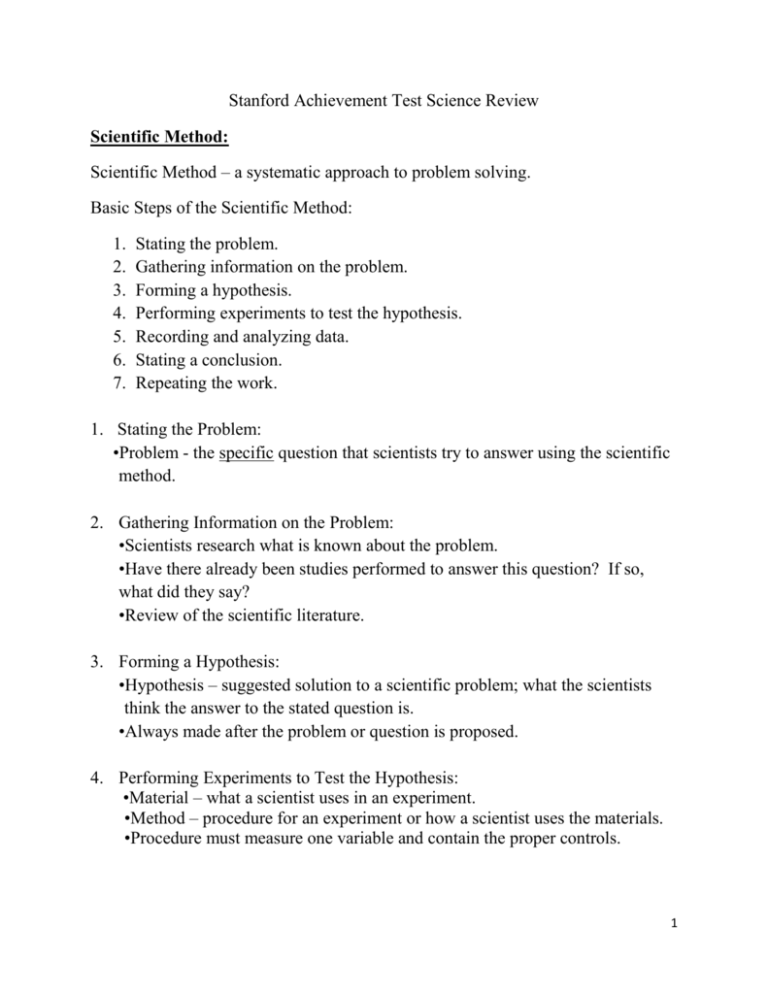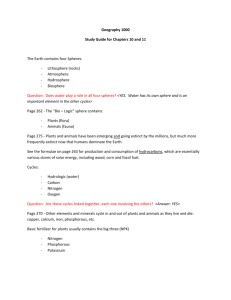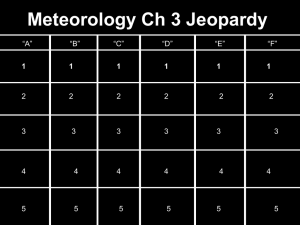Scientific Method - The Anthony School
advertisement

Stanford Achievement Test Science Review Scientific Method: Scientific Method – a systematic approach to problem solving. Basic Steps of the Scientific Method: 1. 2. 3. 4. 5. 6. 7. Stating the problem. Gathering information on the problem. Forming a hypothesis. Performing experiments to test the hypothesis. Recording and analyzing data. Stating a conclusion. Repeating the work. 1. Stating the Problem: •Problem - the specific question that scientists try to answer using the scientific method. 2. Gathering Information on the Problem: •Scientists research what is known about the problem. •Have there already been studies performed to answer this question? If so, what did they say? •Review of the scientific literature. 3. Forming a Hypothesis: •Hypothesis – suggested solution to a scientific problem; what the scientists think the answer to the stated question is. •Always made after the problem or question is proposed. 4. Performing Experiments to Test the Hypothesis: •Material – what a scientist uses in an experiment. •Method – procedure for an experiment or how a scientist uses the materials. •Procedure must measure one variable and contain the proper controls. 1 •Variable - what is tested or measured in an experiment; what is different among tested groups; scientists only test one variable at a time; is absent from control group •Control - what is held same or constant in an experiment; what is the same among experimental groups; a control group is used as a comparison group for the experimental group which has the variable being tested. 5. Recording and Analyzing Data: • Scientists keep a notebook/reflection journal while the experiment is conducted to record data. •Data - objective measurements (numbers) and/or observations. •All measurements must include proper units. •Scientists construct tables and graphs to present data. The advantage of tables and graphs is that it makes it easier for readers to understand the data. 6. Stating a Conclusion: •Scientists analyze the data (interpret graphs) to write a conclusion. Life Science: Adaptation - an inherited trait that helps a species survive in its unique environment; happens over many, many years to the entire species, not just overnight to one individual. Types of Adaptations: 1. Structural= adaptations involving body part shape or coloring - peppered moth example - 1850s, Industrial Revolution 2. Behaviors= adaptations involving the actions of an organism. - examples: escaping danger, building shelters, gathering or capturing food, finding a mate, reproducing, and caring for young. 2 types of behavior: 1. inherited behavior - any behavior that an organism is born with - instincts, reflexes 2 2. learned behavior - behavior that an organism is not born with but must learn from others - imprinting of ducklings is an inherited behavior that allows them to learn important behaviors from the mother. No other organism has to teach them to follow their mother, but their mother has to teach them how to survive. 3. Body processes=go on inside an organism’s body. -includes hibernation (slowing down body processes during cold months-body temperature drops, heart rate and breathing rate slow down) Cell Respiration: sugar + oxygen carbon dioxide + water + energy Sugar-from food we eat, oxygen-from air we breathe in (inspire), carbon dioxidewe breathe out (expire), water-we excrete Photosynthesis: carbon dioxide + water + sun’s energy sugar + oxygen Osmosis – movement of water from area of high water concentration to an area of low water concentration; water moves into a cell-cell will swell and may burst; water moves out of a cell- cell will shrink. Mitosis - process by which a parent cell produces two new identical daughter cells with the same # of chromosomes Stages of Mitosis (cell cycle) 1. Interphase - stage of cell growth, chromosomes duplicate in preparation for next mitosis 2. Prophase - nuclear membrane disappears, chromosomes become visible 3. Metaphase - chromosomes line up at middle of cell 4. Anaphase - chromosomes separate to opposite poles of cell 5. Telophase - cell division occurs, 2 new identical daughter cells produced Nitrogen Cycle: Nitrogen is used to make proteins by all living things 3 Nitrogen makes up about 80% of earth's atmosphere but organisms can't use it directly Nitrogen-fixing bacteria convert nitrogen gas into nitrogen compounds - plants get nitrogen compounds from groundwater - nitrogen compounds move through food web in proteins - animals die and decomposers release nitrogen gas back into environment Lightning reacts nitrogen gas with oxygen to form nitrogen compounds - plants get nitrogen compounds from rain water - nitrogen compounds move through food web in proteins - animals die and decomposers release nitrogen gas back into environment Water Cycle: -Water is necessary for all life. -Many chemical reactions that take place in organisms to keep them alive occur in water. -As sun heats lakes, streams, etc. water evaporates (changes from liquid to a gas) to form water vapor. Leaves transpire water vapor. Animals and humans breathe out water vapor. -Water vapor enters air, rises, and cools. -As water cools, it condenses (changes from gas to a liquid). -Clouds form when water vapor condenses on dust or salt particles in air. Water falls to Earth’s surface as precipitation=rain, snow, or hail. Land Biomes: Biome = collection of similar ecosystems with similar climates and communities - climate changes with latitude and altitude - latitude near equator vs. latitude nears poles - higher altitude --> lower temperatures 4 1. tundra - permafrost - ground that is permanently frozen - avg. precipitation 20 cm - temperatures -57degrees C to 10 degrees C 2. taiga - coniferous forests-firs, pines, spruces, cedars, redwoods - avg. precipitation 50 cm - temperatures -29 degrees C to 22 degrees C 3. temperate deciduous forest - trees lose leaves every year, 4 seasons, rich soil, maple and oak trees - avg. precipitation 125 cm - temperatures -20 degrees C to 35 degrees C 4. grassland - 4 seasons, very fertile soil, few trees, a lot of grass - avg. precipitation 50 cm - temperatures -35 degrees C to 30 degrees C 5. tropical rain forest - no seasons, trees are main storage place of nutrients, poor and thin soil - avg. precipitation 200 cm - temperatures 20 degrees C to 33 degrees C 6. desert - very dry, soils low in nutrients - avg. precipitation 12 cm 5 - temperatures 0 degrees C to 32 degrees C food chain - model showing how energy and nutrients move through an ecosystem; most food chains have 5 links or less (producer, primary consumer, secondary consumer, tertiary consumer, decomposer) food web - different food chains linked together energy pyramid - model showing how energy is used in a food chain or ecosystem Less energy is available at any level in the pyramid than in the level below it. Why? Organisms at each level use some of the energy they get from the step below to carry on their life processes; some energy also is lost as heat. Pollination – when an insect visits a plant, pollen can rub off onto the insect and be carried to other plants. Physical Science: Chemical Reactions: Chemical reaction=process in which the physical and chemical properties of the reactants change as new substances (products) with different physical and chemical properties are formed - reactant = starting material - product = material that is produced Chemical Formula= shorthand way of representing a compound; examples: NaCl=table salt, H2O=water, C6H12O6=sugar. Mixture-combination in which the substances are not chemically combined; substances retain their own properties; For example, when sugar is dissolved in water, its sweet taste remains. Mixtures can be separated by simple physical means-magnet, filter paper, evaporation. Solution - mixture in which the particles of different substances are evenly distributed and are too small to see with the naked eye. 6 - appears to be a single substance 2 Parts of a Solution: solute and solvent solute - material that is dissolved solvent - substance that dissolves other materials Solubility= maximum amount of solute that can be dissolved in a solvent at a particular temperature. How to increase rate of dissolving: 1. Stirring solution 2. Heating solvent 3. Breaking the solute into smaller pieces - any action which increases the number of collisions between solvent and solute particles Pressure is the force exerted by the particles in a substance per unit area. Pressure = Force/Area Energy – the ability to do work Types of Energy: 1. Potential Energy – energy of position 2. Kinetic Energy – energy of motion Example: Lifting a rock gives it potential energy, letting the rock fall gives it kinetic energy. 3. Electromagnetic Energy – electricity and light 4. Thermal Energy – energy associated with how warm a substance is 5. Chemical Energy – energy associated with chemical reactions; burning 7 Speed = distance ÷ time Units of speed: kilometers per hour (km/hr), meters per second (m/s) Acceleration – change in speed (m/s) in a certain amount of time (sec.) Graph: Deceleration – negative acceleration Graph: Lever – a simple machine; example- seesaw; a lever is a rigid bar that is free to pivot or move about a fixed point called a fulcrum. 8 Earth Science: Earth’s Layers: 1. Crust –outermost thin layer; part we live on; made of oxygen combined with silicon, aluminum, iron, and calcium. 2. Mantle – middle thick layer; most of Earth’s mass; outer mantle is solid like crust, inner mantle is hot so rock can flow; made mostly of oxygen combined with silicon, magnesium, and iron. 3. Core – inner compact layer; temperature of core is about 7,000 degrees Celsius; outer core is liquid (hot), inner core is solid. Lithosphere – Earth’s crust and the upper part of the mantle; broken into pieces called tectonic plates that fit together like pieces in a jigsaw. Alfred Wegener – German scientist who suggested an explanation for the fit of the coastlines; thought all continents were joined as Pangaea 225 million years ago; Pangea broke apart – continental drift- theory that continents drifted apart in the past and continue to do so. Evidence for Continental Drift: 1. Shape of continents 2. Rock layers along eastern coast of South America match layers along western coast of Africa. 3. Animal and plant fossils layers along eastern coast of South America match fossils along western coast of Africa. 9 Continental Drift was rejected by some scientists because Wegener was unsure of what forces could be strong enough to move continents. What causes plates to move apart? Hot liquid currents in the mantle constantly rise (hot), circle around , and fall (cool) because of convection; when mantle moves, the plates floating on it move. Plate Tectonics – Earth’s lithosphere is broken into 20 moving plates; the continents and ocean floor make up these moving parts. Fault – break in Earth’s crust. Plate boundaries – where two plates meet: Fracture boundary – two plates slide past each other; causes faults Colliding boundary – two plates collide with each other; causes mountains Spreading boundary – two plates move away from each other; causes ridges What causes earthquakes? Sudden shifting of rock as tectonic plates shift positions. Energy of earthquakes is carried in waves that spread out from focus and epicenter. Underground point where earthquake occurs is called focus. Point on Earth’s surface directly over focus is called epicenter. Most earthquakes take place near edges of plates. Strength of earthquakes measured on Richter Scale – each increase of 1 indicates a 31 times more energy is released. What causes volcanoes to erupt? Magma from the mantle either flows or explodes through the crust. Lava – magma that reaches Earth’s surface. Natural changes after volcanic eruption: 10 1. Land is bare 2. Only burrowing animals and some buried seeds survive 3. Plants slowly grow back 4. Plants make soil more fertile and animals gradually move back into area Soil is made from weathered rock, air, water, and the remains of living organisms. Weathering can be caused by frost, drought, change in temperature, and rainwater. Organic matter – any substance that is made of living things or the remains of living things. Humus – dark-colored, organic matter formed from decayed plant and animal remains; rich in nutrients needed by plants. Layers of soil: 1. Topsoil – mixture of small rock pieces, humus, and other organic matter; where most of the living things are found; often covered by loose organic matter like dead leaves or twigs. 2. Subsoil – made of minerals carried away from the topsoil by rainwater; has less organic matter than topsoil so it is lighter in color. 3. Parent rock material – very little organic matter. Factors that Affect Soil: 1. Climate – most important; weathering takes place more quickly with a lot of rainfall and warm temperatures. 2. Kind of rock that forms it – affect characteristics like color; soil color is also affected by amount of organic matter; more organic matter the darker the color. 3. Shape of Land – mountains usually have thin layers of topsoil because of erosion; flat land has a thick topsoil. Relative dating – allows scientists to learn the relative age of each rock layer and the materials found in it; lets scientists place past events in sequential order (oldest rock layers on bottom); cannot reveal how long ago each event occurred. 11 How Coal Forms: 1. Dead swamp plants sink to bottom of swamp water and form peat. 2. Heat and pressure from sediment layers above peat slowly change it into lignite (brownish-black coal with a lot of water). 3. More heat and pressure change lignite to bituminous coal (most common form used in U.S.). 4. Anthracite- hardest form of coal. Earth – rotates on an axis, an imaginary line between the North and South poles. Half of the Earth is tilted slightly more towards the Sun – more daylight than nighttime. Other half of the Earth has fewer daylight and more nighttime. Late March – neither hemisphere is towards Sun; Northern Hemisphere – spring, Southern Hemisphere – fall. Late June – Northern Hemisphere tilted towards Sun; Northern Hemisphere – summer, Southern Hemisphere – winter. Late September - neither hemisphere is towards Sun; Northern Hemisphere – fall, Southern Hemisphere – spring. Late December – Southern Hemisphere tilted towards Sun; Northern Hemisphere – winter, Southern Hemisphere – summer. Solar Eclipse – Moon blocks Sun; Moon is between Sun and Earth. Lunar Eclipse – Moon passes through Earth’s shadow; Moon is behind Earth. Planets move or orbit Sun. Front – boundary that forms between two air masses; weather at a front is often stormy or cloudy. Air density is inversely related to temperature (hot air rises and cold air falls). The angle at which sunlight hits a particular area on Earth is a determining factor in the area’s climate. 12








